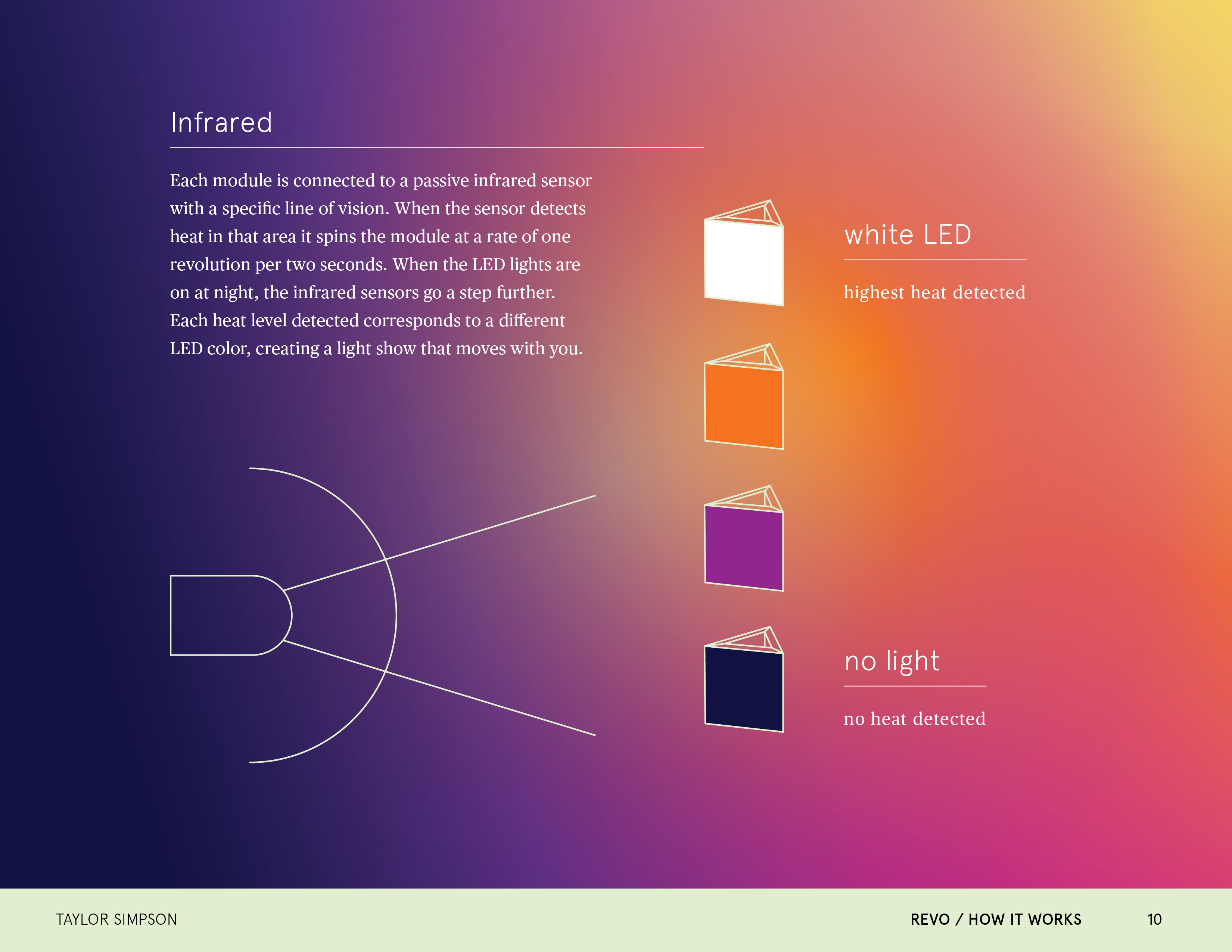interactive installation design
Revo
2017

Set in a public plaza, Revo gives passersby a space to walk through, relaxed and engaged with their surroundings. Its gridded ten foot walls are made of six inch 3D printed modules made from semitransparent recycled plastics such as milk cartons and water bottles. Each module is a triangular prism, with a flower or leaf on each side. When someone walks through, infrared sensors are triggered and spin the modules, creating a garden wave.
In the daytime, UV sensitive pigments in the plastics allow the differents sides of the modules to change colors when exposed. At night, the infrared sensors use their temperature detection to turn and LED light inside the module the corresponding color.
In the daytime, UV sensitive pigments in the plastics allow the differents sides of the modules to change colors when exposed. At night, the infrared sensors use their temperature detection to turn and LED light inside the module the corresponding color.
Revo is powered by solar power hotspots set level with the plaza. They are protected by thick safety glass so there is no concern about wear or people walking on them.
In this particular environment, Revo is representative of a maze-like garden. But because the modules are 3D printed, there are endless possibilities for form. They don’t have to be leaves and flowers, but can be anything. Patterns could fill facades, and stripped down to the bare elements (no infrared sensors), Revo could be purely interactive by touch.
In this particular environment, Revo is representative of a maze-like garden. But because the modules are 3D printed, there are endless possibilities for form. They don’t have to be leaves and flowers, but can be anything. Patterns could fill facades, and stripped down to the bare elements (no infrared sensors), Revo could be purely interactive by touch.



Inspiration
Richard Serra
Daniel Rozin


Technology
Recycled Plastics
Plastics are shredded, then undergo processes to eliminate impurities like paper labels. This material is melted and often extruded into the form of pellets which are then used to manufacture other products.
3D Printing
A 3D model file (usually CAD) is uploaded to a 3D printer. The 3D printer reads every slice (2D image) and creates a three dimensional object out of the recycled plastic filaments.
Plastics are shredded, then undergo processes to eliminate impurities like paper labels. This material is melted and often extruded into the form of pellets which are then used to manufacture other products.
3D Printing
A 3D model file (usually CAD) is uploaded to a 3D printer. The 3D printer reads every slice (2D image) and creates a three dimensional object out of the recycled plastic filaments.
UV Sensitive Pigments
When exposed to UV rays, a light frequency invisible to the human eye, these pigments show color. These are mixed into the recyled plastics when making the filaments for 3D printing.
Infrared Sensors
Passive infrared motion detectors (PIR) detect emitted infrared energy, given off by humans and
animals in the form of heat.
Solar Power
Photovoltaic cells convert sunlight into direct current energy throughout the day.
When exposed to UV rays, a light frequency invisible to the human eye, these pigments show color. These are mixed into the recyled plastics when making the filaments for 3D printing.
Infrared Sensors
Passive infrared motion detectors (PIR) detect emitted infrared energy, given off by humans and
animals in the form of heat.
Solar Power
Photovoltaic cells convert sunlight into direct current energy throughout the day.